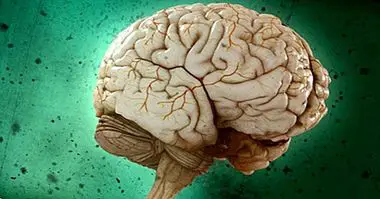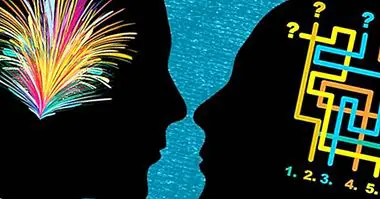The 7 types of sensations, and what information they capture
People are in constant contact with everything that surrounds us and the information we receive from our environment is what allows us to interact with it effectively. This information is given by the different types of sensations .
However, the sensations are not limited only to external stimuli; but also there are stimuli generated by our own body that inform us of the state in which we find ourselves. Throughout this article we will discuss the different types of sensations and the characteristics of each one of them.
- Maybe you're interested: "The 15 types of hallucinations (and their possible causes)"
The sensations in psychology
In the field of psychology, a sensation refers to the phenomenon by which our body detects a stimulus or stimulation, both internal and external . A sensation caused by an external stimulus can be, for example, to feel a caress; while an internal sensation can be a headache or feel the noises that our empty stomach emits.
This concept is always accompanied by the concept of perception. However, there is a fundamental difference between the two. While the sensation is the mere detection of the stimulus , the perception consists of the organization, identification and interpretation of said sensory information, with the objective of interpreting and understanding this information of our environment.
Its phases
Within a sensory information detection process we find three different phases.
1. Physical phase
In it the stimulus activates the corresponding sensory receptor organ.
2. Physiological phase
A chain reaction occurs in our organism, generating the known process of transduction by which sensory information becomes neuronal information and activating a series of structures of the nervous system.
3. Psychological phase
In this last phase the person is aware of the sensation, which provokes a reaction or response. Here, to become part of the perception process .
Usually, we are taught that people have five basic senses: sight, hearing, taste, smell and touch. However, we are able to perceive many more less known senses. Among them we find the kinesthetic sense and the kinesthetic sense.
Types of sensations
As we mentioned earlier, the sensations can be classified into different types. In addition, these can be classified into subgroups depending on whether they respond to external or internal stimuli.
Within the group of external senses are:
- Eyesight.
- Sense of touch.
- Auditory sense
- Olfactory sense
On the other hand, the internal senses include:
- Cenesthetic sense.
- Kinesthetic sense.
1. Visual sense
The sense of sight is the one in charge of detecting those sensations created when the person observes or looks at their surroundings. Within this same sense we found two types of different visual sensations :
- Chromatic sensations : generated by the detection of colors.
- Achromatic sensations : sensations generated by the degree of clarity of the environment. This goes from white to absolute black.
The detection of the wavelength, the intensity and the complexity of the light are possible thanks to the visual receptors located in the retina of the eye. These receptors are known as rods and cones.
While the rods are sensitive to dim light, the cones capture the variety of colors and bright light. The sensory information obtained by these receptors translates into neuronal information that travels along the optic nerve.
When this sense fails for any cause and at any level, different types of blindness appear, including the complete inability to see.
- Related article: "The 11 parts of the eye and its functions"
2. Auditory sense
Also known as an ear, this sense allows us to detect the sounds that reach the internal mechanism of the auditory organ in the form of vibrations and changes in the pressure of the medium. These sensations may be different depending on the height and tone, as it also varies depending on the tone.
Characteristics such as frequency, intensity and complexity of sound waves that come to us from the external environment are detected by the hearing receptors of the ear. In this case the receptors are known as cilia or ciliated cell receptors.
The different patterns of movement of the cilia are translated into different neural codes, which ultimately lead to a different hearing of the volume, tone and timbre of the sounds.
In this sense, the loss of the ability to listen is known as deafness, which can also appear in different degrees and affect one or both ears.
3. Olfactory sense
The ability to perceive the aromas and smells of the medium is known as the sense of smell. The appearance of any external fragrance, both pleasant and unpleasant , activates the capillary receptors of the nasal passages. These receptors transfer the signal to the olfactory bulb, located at the base of the brain.
The sense of smell can serve many purposes such as detecting hazards (smelling a gas leak), spoiled food or the detection of pheromones, among many others. In addition, it is integrated with the sense of taste to effectively perceive the different flavors.
A person who does not possess this ability or has lost it due to some type of injury is a person suffering from anosmia .
4. Sense of taste
Taste is that sensation produced by a chemical reaction that occurs when a substance is detected by the taste receptor cells, located in the taste buds of the oral cavity , mainly in the language.
The taste receptors are activated by the presence of food or any other element placed on the tongue. Taste buds can detect four basic tastes: sweet, salty, sour and bitter. However, the sense of taste works together with the smell and stimulation of the trigeminal nerve to determine the different flavors, as well as the temperature of these.
With the passage of time and aging, there is a decrease in the intensity of the perception of different flavors, while the complete inability to perceive them is known as ageusia .
5. Sense of touch
The sense of touch is one whose sensations respond to changes in the surface of the body. That is, the skin of the person; which can feel all that stimulus or element that touches it.
Through the sense of touch we can perceive and identify the characteristics of objects. It allows us to know if it is soft, rough or rough. In the same way, can also tell us about the temperature of the objects by activating the thermoreceptors.
The sensory information receptor cells are connected to the afferent nerve fibers. Upon detection of a tactile stimulus, the sensory receptors are activated by transporting the information to the corresponding brain centers.
6. Kinesthetic sense or proprioception
Kinestesia, or proprioception, refers to the ability to detect the position of muscles, as well as the ability to be aware of the position or position of our body in relation to what surrounds us. This sense makes it possible to control the direction and range of our movements, which allows us to give fast and automatic motor responses.
In comparison with the senses described above, kinesthesia is an interoceptive sentive, that is, it is responsible for detecting the stimuli and internal states of our organism.
As a consequence, it also plays an important role in the perception and maintenance of balance, as well as in the coordination of movements . On the other hand, the dysfunctions related to this sense are those that are manifested through motor clumsiness, falls and lack of coordination.
- Maybe you're interested: "The illusion of the rubber hand: a curious psychological effect"
7. Cenesthetic sense
Finally, kinesthetic or kinesthetic sense is one of the least known senses and is responsible for detecting the set of internal sensations of our body. The receptor units of this sense are those nerve endings of the membranes of the internal organs. It informs about the state of the organs and of the organism in its entirety . The stimuli that activate them are those of the digestive, respiratory and muscular physiology, among others.
In some areas, they refer to the cenesthesia as the general feeling of the existence of our own body and the state in which it is located.



















